Intel Rocket Lake (14nm) Review: Core i9-11900K, Core i7-11700K, and Core i5-11600K
by Dr. Ian Cutress on March 30, 2021 10:03 AM EST- Posted in
- CPUs
- Intel
- LGA1200
- 11th Gen
- Rocket Lake
- Z590
- B560
- Core i9-11900K
CPU Tests: Encoding
One of the interesting elements on modern processors is encoding performance. This covers two main areas: encryption/decryption for secure data transfer, and video transcoding from one video format to another.
In the encrypt/decrypt scenario, how data is transferred and by what mechanism is pertinent to on-the-fly encryption of sensitive data - a process by which more modern devices are leaning to for software security.
Video transcoding as a tool to adjust the quality, file size and resolution of a video file has boomed in recent years, such as providing the optimum video for devices before consumption, or for game streamers who are wanting to upload the output from their video camera in real-time. As we move into live 3D video, this task will only get more strenuous, and it turns out that the performance of certain algorithms is a function of the input/output of the content.
HandBrake 1.32: Link
Video transcoding (both encode and decode) is a hot topic in performance metrics as more and more content is being created. First consideration is the standard in which the video is encoded, which can be lossless or lossy, trade performance for file-size, trade quality for file-size, or all of the above can increase encoding rates to help accelerate decoding rates. Alongside Google's favorite codecs, VP9 and AV1, there are others that are prominent: H264, the older codec, is practically everywhere and is designed to be optimized for 1080p video, and HEVC (or H.265) that is aimed to provide the same quality as H264 but at a lower file-size (or better quality for the same size). HEVC is important as 4K is streamed over the air, meaning less bits need to be transferred for the same quality content. There are other codecs coming to market designed for specific use cases all the time.
Handbrake is a favored tool for transcoding, with the later versions using copious amounts of newer APIs to take advantage of co-processors, like GPUs. It is available on Windows via an interface or can be accessed through the command-line, with the latter making our testing easier, with a redirection operator for the console output.
We take the compiled version of this 16-minute YouTube video about Russian CPUs at 1080p30 h264 and convert into three different files: (1) 480p30 ‘Discord’, (2) 720p30 ‘YouTube’, and (3) 4K60 HEVC.
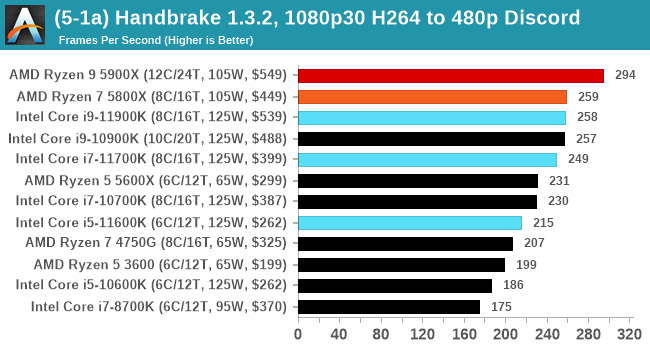
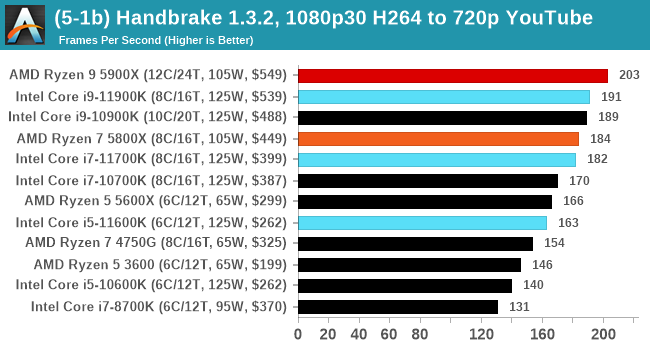
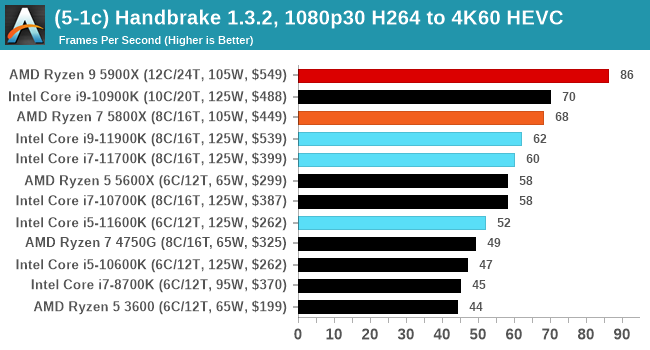
Up to the final 4K60 HEVC, in CPU-only mode, the Intel CPU puts up some good gen-on-gen numbers.
7-Zip 1900: Link
The first compression benchmark tool we use is the open-source 7-zip, which typically offers good scaling across multiple cores. 7-zip is the compression tool most cited by readers as one they would rather see benchmarks on, and the program includes a built-in benchmark tool for both compression and decompression.
The tool can either be run from inside the software or through the command line. We take the latter route as it is easier to automate, obtain results, and put through our process. The command line flags available offer an option for repeated runs, and the output provides the average automatically through the console. We direct this output into a text file and regex the required values for compression, decompression, and a combined score.
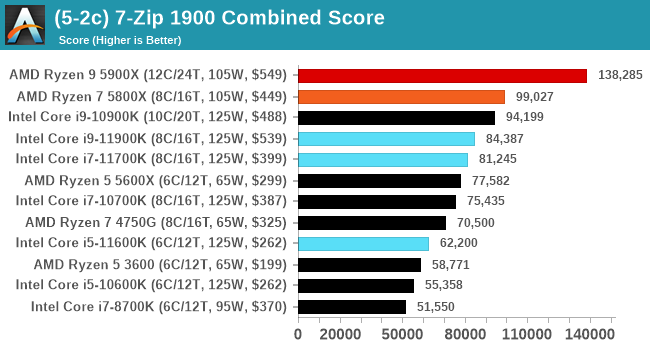
AES Encoding
Algorithms using AES coding have spread far and wide as a ubiquitous tool for encryption. Again, this is another CPU limited test, and modern CPUs have special AES pathways to accelerate their performance. We often see scaling in both frequency and cores with this benchmark. We use the latest version of TrueCrypt and run its benchmark mode over 1GB of in-DRAM data. Results shown are the GB/s average of encryption and decryption.
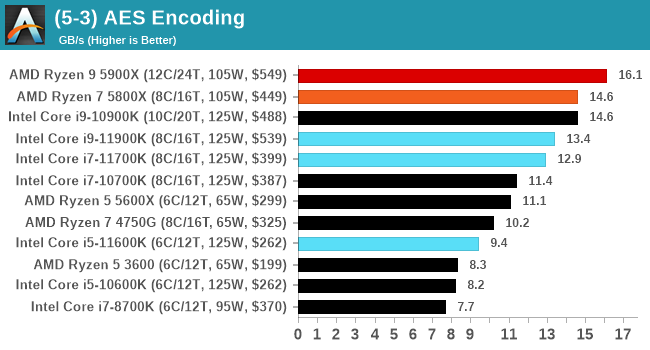
WinRAR 5.90: Link
For the 2020 test suite, we move to the latest version of WinRAR in our compression test. WinRAR in some quarters is more user friendly that 7-Zip, hence its inclusion. Rather than use a benchmark mode as we did with 7-Zip, here we take a set of files representative of a generic stack
- 33 video files , each 30 seconds, in 1.37 GB,
- 2834 smaller website files in 370 folders in 150 MB,
- 100 Beat Saber music tracks and input files, for 451 MB
This is a mixture of compressible and incompressible formats. The results shown are the time taken to encode the file. Due to DRAM caching, we run the test for 20 minutes times and take the average of the last five runs when the benchmark is in a steady state.
For automation, we use AHK’s internal timing tools from initiating the workload until the window closes signifying the end. This means the results are contained within AHK, with an average of the last 5 results being easy enough to calculate.
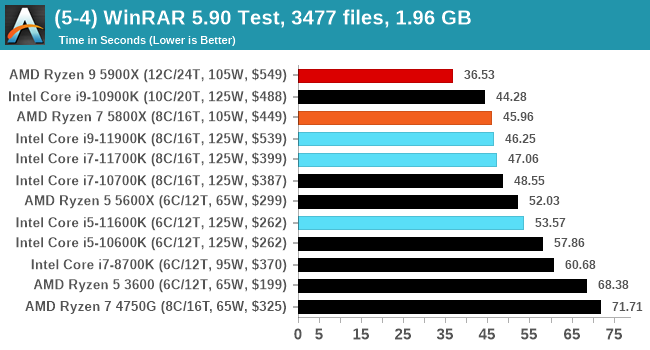
CPU Tests: Synthetic
Most of the people in our industry have a love/hate relationship when it comes to synthetic tests. On the one hand, they’re often good for quick summaries of performance and are easy to use, but most of the time the tests aren’t related to any real software. Synthetic tests are often very good at burrowing down to a specific set of instructions and maximizing the performance out of those. Due to requests from a number of our readers, we have the following synthetic tests.
Linux OpenSSL Speed: SHA256
One of our readers reached out in early 2020 and stated that he was interested in looking at OpenSSL hashing rates in Linux. Luckily OpenSSL in Linux has a function called ‘speed’ that allows the user to determine how fast the system is for any given hashing algorithm, as well as signing and verifying messages.
OpenSSL offers a lot of algorithms to choose from, and based on a quick Twitter poll, we narrowed it down to the following:
- rsa2048 sign and rsa2048 verify
- sha256 at 8K block size
- md5 at 8K block size
For each of these tests, we run them in single thread and multithreaded mode. All the graphs are in our benchmark database, Bench, and we use the sha256 results in published reviews.
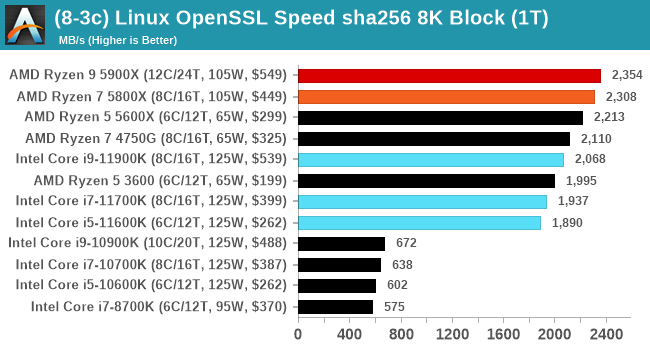
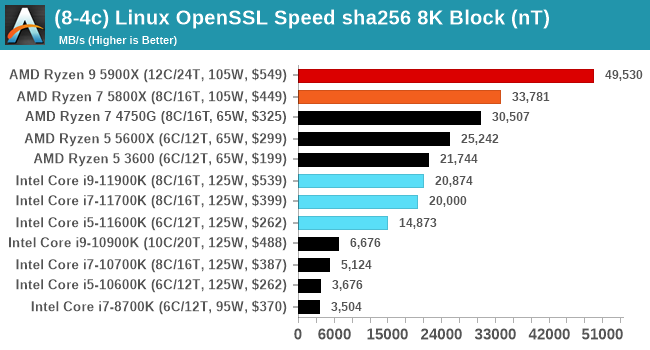
Intel comes back into the game in our OpenSSL sha256 test as the AVX512 helps accelerate SHA instructions. It still isn't enough to overcome the dedicated sha256 units inside AMD.
CPU Tests: Legacy and Web
In order to gather data to compare with older benchmarks, we are still keeping a number of tests under our ‘legacy’ section. This includes all the former major versions of CineBench (R15, R11.5, R10) as well as x264 HD 3.0 and the first very naïve version of 3DPM v2.1. We won’t be transferring the data over from the old testing into Bench, otherwise it would be populated with 200 CPUs with only one data point, so it will fill up as we test more CPUs like the others.
The other section here is our web tests.
Web Tests: Kraken, Octane, and Speedometer
Benchmarking using web tools is always a bit difficult. Browsers change almost daily, and the way the web is used changes even quicker. While there is some scope for advanced computational based benchmarks, most users care about responsiveness, which requires a strong back-end to work quickly to provide on the front-end. The benchmarks we chose for our web tests are essentially industry standards – at least once upon a time.
It should be noted that for each test, the browser is closed and re-opened a new with a fresh cache. We use a fixed Chromium version for our tests with the update capabilities removed to ensure consistency.
Mozilla Kraken 1.1
Kraken is a 2010 benchmark from Mozilla and does a series of JavaScript tests. These tests are a little more involved than previous tests, looking at artificial intelligence, audio manipulation, image manipulation, json parsing, and cryptographic functions. The benchmark starts with an initial download of data for the audio and imaging, and then runs through 10 times giving a timed result.
We loop through the 10-run test four times (so that’s a total of 40 runs), and average the four end-results. The result is given as time to complete the test, and we’re reaching a slow asymptotic limit with regards the highest IPC processors.

Google Octane 2.0
Our second test is also JavaScript based, but uses a lot more variation of newer JS techniques, such as object-oriented programming, kernel simulation, object creation/destruction, garbage collection, array manipulations, compiler latency and code execution.
Octane was developed after the discontinuation of other tests, with the goal of being more web-like than previous tests. It has been a popular benchmark, making it an obvious target for optimizations in the JavaScript engines. Ultimately it was retired in early 2017 due to this, although it is still widely used as a tool to determine general CPU performance in a number of web tasks.
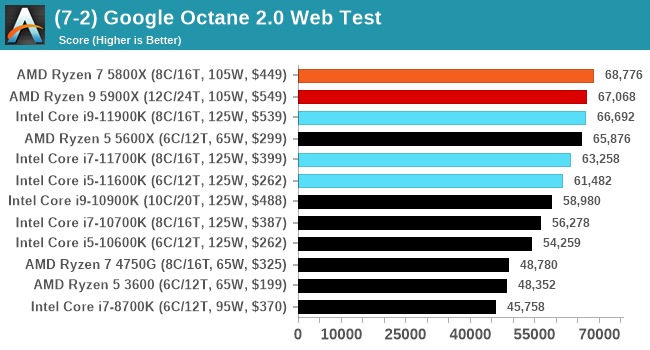
Speedometer 2: JavaScript Frameworks
Our newest web test is Speedometer 2, which is a test over a series of JavaScript frameworks to do three simple things: built a list, enable each item in the list, and remove the list. All the frameworks implement the same visual cues, but obviously apply them from different coding angles.
Our test goes through the list of frameworks, and produces a final score indicative of ‘rpm’, one of the benchmarks internal metrics.
We repeat over the benchmark for a dozen loops, taking the average of the last five.
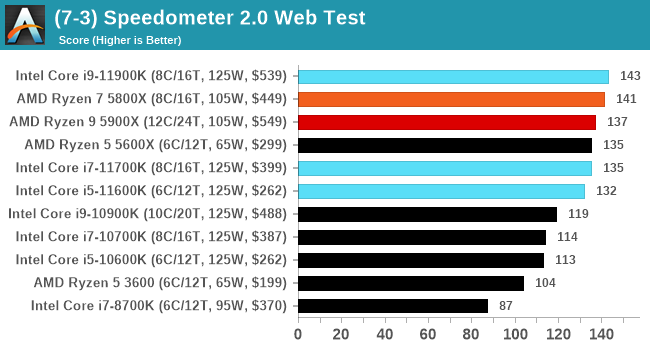
Legacy Tests
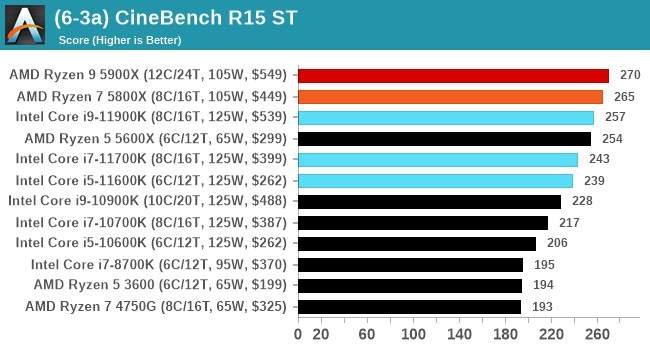

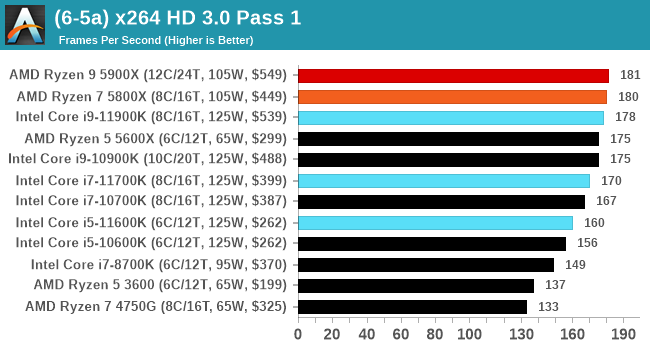
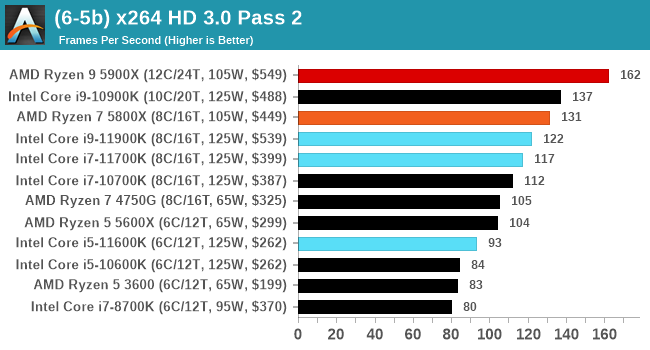


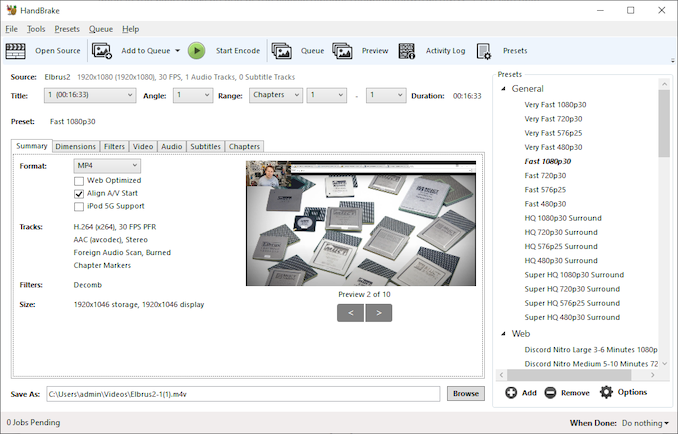
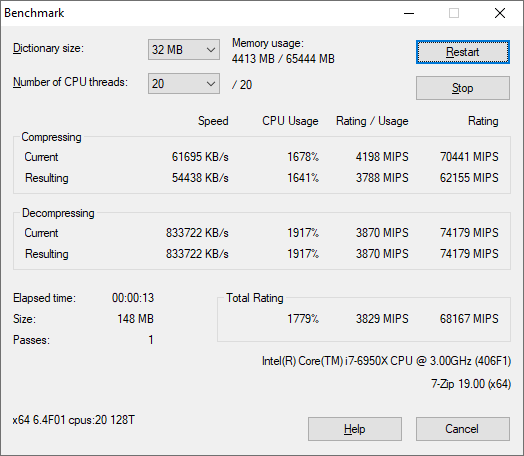
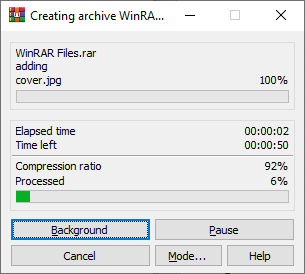

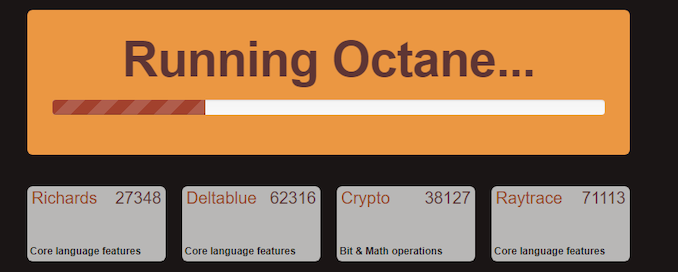
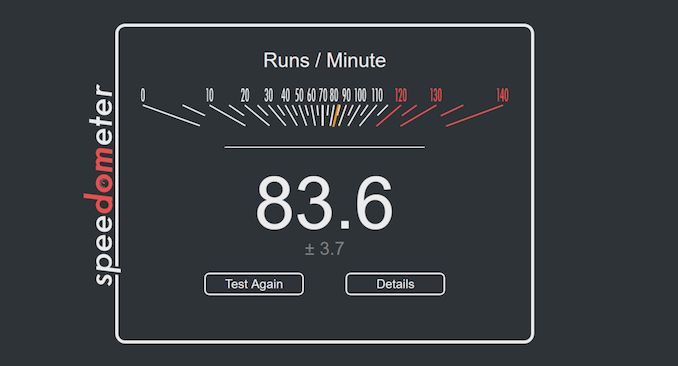








279 Comments
View All Comments
ozzuneoj86 - Thursday, April 1, 2021 - link
"Rocket Lake also gets you PCIe 4.0, however users might feel that is a small add-in when AMD has PCIe 4.0, lower power, and better general performance for the same price."If a time traveling tech journalist would have told us back in the Bulldozer days that Anandtech would be writing this sentence in 2021 in a nonchalant way (because AMD having better CPUs is the new normal), we wouldn't have believed him.
Hrel - Friday, April 2, 2021 - link
Just in case anyone able to actually affect change reads these comments, I'm not even interested in these because the computer I built in 2014 has a 14nm processor too... albeit with DDR 3 RAM but come on, DDR4 isn't even much of a real world difference outside ultra specific niche scenarios.Intel, this is ridiculous, you're going to have been on the SAME NODE for a DECADE HERE!!!!
Crying out loud 10nm has been around for longer than Intels 14nm, this is nuts!
James5mith - Saturday, April 3, 2021 - link
" More and more NAS and routers are coming with one or more 2.5 GbE ports as standard"No, they most definitely are not. lol
Linustechtips12#6900xt - Monday, April 5, 2021 - link
gotta say, love the arguments on page 9 lolpeevee - Monday, April 5, 2021 - link
"the latest microcode from Intel should help increase performance and cache latency"Do we really want the increase in cache latency? ;) :)
8 Cores is Enough - Wednesday, August 4, 2021 - link
I just bought the 11900k with a z590 Gigabyte Aorous Pro Ax mobo and Samsung 980 pro 500GB ssd. This replaced my 9900k in a z390 Gigabyte Aurous Master with a 970 pro 512GB ssd.They're both 14nm node processors with 8c/16t and both overclocked, 5GHz all cores for 9900k and 5.2GHz all cores with up to 5.5GHz on one core via tiurbo modes on the 11900k.
However, the 11900k outperforms the 9900k in every measure. In video encoding, which I do fairly often, it's twice as fast. In fact, the 11900k can comvert 3 videos at the same time each one as fast as my rtx 2070 super can do 1 video af a time.
On UserBenchmark.com, my 11900k is the current record holder for fastest 11900k tested. It beats all the 10900k's even in the 64 thread server workload metric. It loses to the 5900x and 5950x in this one metric but clobbers them botb in the 1, 2, 4 and 8 core metrics.
I wish I had a 5900x to test on Wondershare Uniconverter. I suspect my 11900k would match it given the 2X improvement over the 9900k, which was about 1/2 as fast as the 3950x in video comversion.
I do a lot of video editing as well. Maybe on this workload an AMD 5900x or 5950x would beat the 11900k. It seems plausible so let's presume this and accept Ryzen 9 is most likely still best for video editing.
But the cliam thaf being stuck on 14nm node means Intel RKL CPUs perform the same as Haswell or that they are even close does not make sense to me based on my experiences so far going from coffee lake refresh to RKL.
The Rocket Lake CPUs are like the muscle cars of 1970. They are inefficient beasts that haul buttocks. They exist as a matter of circumstance and we may never see the likes of them again.
Faster more efficient CPUs will be built but the 11th gen Intel CPUs will be remembered for being the back ported abominations they are: thirsty and fast with the software of 2021 which for the time being still favors single thread processing.
If you play Kerbal Space Program then get an 11900k because that game is all about single thread performance and right now the 11900k beats all other CPUs at that.
Germanium - Thursday, September 2, 2021 - link
My experimentation with my Rocket Lake Core I 11700k on my Asus Z590-A motherboard has shown me that it least on some samples AVX512 can be more efficient & cooler running than AVX2 at the same clock speed.I am running my sample at 4.4GHz both AVX512 & AVX2. When running Hand Brake there is nearly a 10 watt savings when running AVX512 as opposed to AVX2.
Before anyone says Hand Brake does not use AVX512 & that is true out of the box but there is a setting script I found online to activate AVX512 on Hand Brake and it does work. It most be manually entered, no copy & paste available.
With stock voltage settings at 4.2GHz using AVX2 at was drawing over 200 watts. With my settings I am able to run AVX512 at 4.4 GHz with peak wattage in Hand Brake of 185 watts. That was absolute peak wattage. It mostly ran between 170 to 180 watts. AVX2 runs about 10 watts more for slightly less performance at same clock speed.
Germanium - Thursday, September 2, 2021 - link
Forgot to mention that on order to make AVX512 so efficient one must set the AVX Guard Band voltage Offset at or near 0 to bring the power to acceptable levels. Both AVX512 & AVX2 must be lowered. If AVX2 is not lowered at least same amount AVX512 setting will have little or no effect.chane - Thursday, January 13, 2022 - link
I hope my post is considered on topicScenario 1: Without discrete graphics 1080p grade card, using on-chip graphics: Given the same core count (but below 10 cores), base and turbo frequencies and loaded with the same Cinebench and/or Handbrake test loads, would a Rocket lake Xeon w series processor run hotter, cooler or about the same as a Rocket Lake i family series processor with the same TDP spec?
Scenario 2: As above but with 1080p grade discrete graphics card.
Note: The Xeon processor pc will be using 16GB of ECC memory, however much that may impact heat and fan noise.
Please advise.
Thanks.